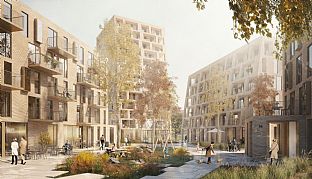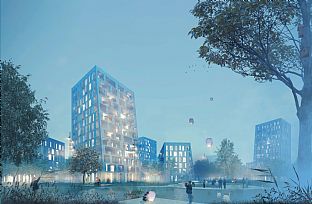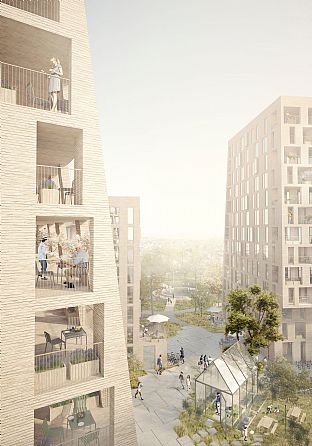C.F. Møller Architects and BRUT win competition in Belgium
The winning proposal by C.F. Møller Architects and BRUT for this new neighbourhood of 500 homes shows how densification on a human scale can improve the quality of life of the residents, the immediate surroundings and the city.
- We are really looking forward to continue our collaboration with BRUT and the clients De Oostendse Haard’ and ‘De Gelukkige Haard to make this visionary project come true. The mix of urban development, sustainability and building design is as a mean to improve life for both people and planet is exactly what we love and excel in, says Lone Wiggers, partner and architect at C.F. Møller Architects.
Redefining the high-rise
The quarter ‘De Nieuwe Stad’ in Ostend, Belgium, was built in 1972 by two social housing associations. The existing buildings are outdated, and the neighbourhood is struggling with the typical problems of post-war social high-rise neighbourhoods. It has been decided to replace the buildings and redevelop the entire site. 54 architectural firms wanted to participate in the competition, four were chosen by the clients De Oostendse Haard’ and ‘De Gelukkige Haard’ and team C.F. Møller Architects and BRUT has been announced as the winners.
- This project offers a unique opportunity to restore the image of high-rise typologies within the context of social housing, especially since the current residents declare they like living in the neighbourhood. After all, high-rise is nowadays very topical in the discussion about densification and is gaining ground in other segments of the housing market, explains Gunther Slagmeulder, architect and partner at BRUT.
Sustainable, innovative and inclusive
The proposal combines the ambitions of the clients and the city of Ostend with the wishes of current and future tenants within an innovative, inclusive and sustainable housing project. At different scales, new qualities are introduced.
On the scale of the city, a new bicycle and walking connection between the city centre and the green belt around the city, following the course of a former creek, ensures that the neighbourhood is taken out of its isolation. On a district scale, The Creek Park, a spacious landscape park increases the quality of life and the opportunities for social interaction and recreation. The ‘Creek Park’ becomes a new green centrality for the neighbourhood and the surrounding residential areas with space for the reopened creek, sustainable water management, recreation, nature and a pleasant path structure.
New neighbourhood, new neighbours
At neighbourhood scale, the sense of community is enhanced by collecting compact 'houses' around 3 distinct forecourts that act as a bridge between the existing and new buildings. Here, the entrances of the ‘houses’ are situated, along with playgrounds, neighbourhood functions on the ground floor and a compact car access and parking system. On the scale of the buildings, a sense of domesticity is stimulated by supplementing comfortably furnished homes with spacious terraces, generous views and shared spaces. The robust and refined architecture combines a strong new identity with quality of living, sustainability, flexibility and feasibility.
Innovative form of living
A family of 10 'block houses' and 4 ‘tall houses' adds a new chapter to the residential landscape of Ostend and maximises the advantages of the position between the city centre and the green belt. The compact 'houses' and the neighbouring apartment blocks are gathered around three forecourts, each with its own character. Inspiration for the architecture was found in the qualities of the existing modernist buildings, which, besides the beautiful view, are also appreciated for the large glazed areas and the wide terraces that offer a feeling of light and space. But also the surrounding residential areas and the historic villas at the Belgian coast were a source of inspiration.
- We combine these types into an innovative form of living that combines density with domesticity, a sense of community and human scale. A housing typology that leaves ample space for a green landscape and maximally profits from this quality, tells Lone Wiggers, partner and architect at C.F. Møller Architects and sums up the joint ambition from C.F. Møller Architects and BRUT.
‘De Nieuwe Stad’ can become a model project for densification on a human scale by focusing on a sustainable urban design with innovative housing typologies, the introduction of a strong sense of community and smart interpretations of social housing and the applicable standards.
Vertical village
C.F. Møller Architects and BRUT are collaborating on another project in Belgium that is being build right now. It is a residential tower in Antwerp.
The aim with this tower block is to break with the traditional multi-storey building trends, which isolate residents. Using a wide range of architectural features, the tower block creates a sustainable, collectively-oriented community. The tower block is characterised by diversity where social encounters are facilitated without sacrificing the need for a private life.
Clients: Social housing companies ‘De Oostendse Haard’ and ‘De Gelukkige Haard’
Address: ‘De Nieuwe Stad’, Ostend, Belgium
Design team: C.F. Møller Architects with BRUT architecture and urban design
Collaborators: ABT Belgium (stability, special techniques, energy, acoustics)
Prizes: 1st prize in international competition, Open Call of the ‘Team Vlaams Bouwmeester’, 2018
Size:
- Project site: 4,8 ha
- Program: approx. 54,000 m², 500 1- & 2-bedroom units, common spaces, collective amenities, commercial spaces
- Creek Park: 3,4ha
Budget: approx. 70M euros excl. VAT







